#treasure mammal
Text





Polly, krill suit (Another Crabs Treasure) and some knives
#not pony#concept#fantasy#design#scifi#polly#mammal#krill#act#another crabs treasure#knife#edc#folding knife#cutlery
103 notes
·
View notes
Text

More for #InternationalZebraDay: Detail from p.189 of the sole known surviving copy of Yi yu tu zhi, c. 1430, from Ming Dynasty China, depicting a zebra (identifiable as a Plains Zebra, Equus quagga) being led by a keeper. [Cambridge Digital Library]
This illustration records what was probably the first zebra seen in China ; it was brought back from Admiral Zheng He's voyage to East Africa (one of the "Ming Treasure Voyages") and presented to the Ming emperor, along with a giraffe and an oryx (also probably the first of each seen in China).
#zebra#zebras#mammals#illustration#book illustration#China#Chinese art#15th century#Ming Dynasty#Zheng He#Ming Treasure Voyages#African animals#Cambridge Digital Library#International Zebra Day#animals in art
18 notes
·
View notes
Text
[Photo ID: A picture of an Eevee. There's an egg shell on its head and it's got a whole hand in its mouth, much probably Clover's]
It's a girl, guys. I'm naming her Chompy for obvious reasons.
#WTF DO I DO NOW#Look I know Charmy also hatched from an Egg but she's a Bug and Bugs are my thing#This is a mammal#I am NOT an expert on mammals#pokeblogging#pokemon#pokeblr#rotomblr#pkmn irl#treasure hunt
1 note
·
View note
Text
Here’s a series of board games I’ve made recently.
Astro Asterid’s Quick Shuttle Repair

Derelict ships in space need to be fixed quickly, so they call on Astro Asterid to repair them! Carry resources through the halls of various ships to repair systems that have crashed. The more resources you carry, the slower you move, and the more likely more systems will go offline! Move quickly but strategically to repair all the systems before time runs out!
Treasure by Torchlight

A single player dungeon crawling role playing game featuring cute little mammal characters in a fantasy setting. Journey through dungeons collecting treasure and defeating monsters to level up your character so you can take on the final boss! But be careful, with every step you take your torchlight grows dimmer. Keep that torch lit as you explore randomly generated dungeons!
Treasure by Torchlight: Bite Size
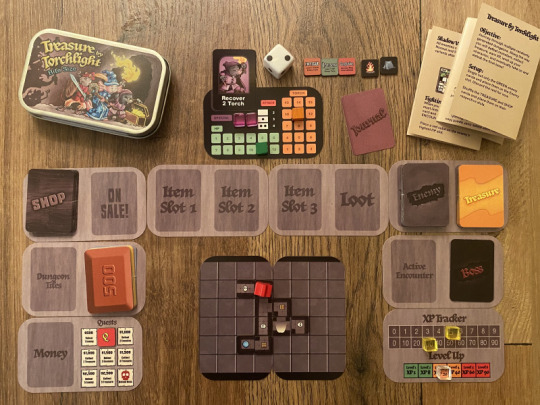
This is a mint-tin version of the same game. This “bite size” version contains everything the full size game does. An enormous game in a tiny package!
Noah’s Ark

A very simple mint-tin game for young players. Move down the landscape collecting animals and bringing them one by one back to the ark. But hurry up! The flood waters are rising! Count up points at the end of the game and see if you got a high score!
The Longest Week

In the middle of a zombie apocalypse you manage to find shelter and call for help. However, help won’t arrive for 7 days. During the day scavenge for weapons, farm for food, or gather resources to strengthen your gate because when night falls the zombie horde attacks! As the days progress the horde outside grows larger and stronger. Can you survive the week and be rescued?
All of these games can be found with more information and prices on my storefront on The Game Crafter website here!
#the game crafter#board games#game crafter#rpg#single player#zombie#noah’s ark#mint tin#zombie apocalypse#dungeon crawler#dungeons and dragons
583 notes
·
View notes
Text
Again?
In where I am tired as shit so I wrote this dumbfuck continuation of a sagau fic as I wait for my fake airpods to finish charging.
Chapter 2 -《 》 - Chapter 4
Navigation
♤-~-♤
Running, you were running. Of the many atrocities you faced, this one was more atrocious than Jake Gyllenhaal. Of all times, WHY NOW? why were you suddenly transported to Teyvat!? Well now you've concluded that... this was in fact not a dream and a case of isekai.
"HALT IN THE NAME OF BARBATOS!"
"FUCK BARBATOS"
Okay, that might've aggravated the knights but in this scenario, who the fuck cares? You're being hunted with nobody on your side, times like these--survival justifies the mean.
With an arrow throught your ankle and forearm you hastily ran for Liyue where you are met with the Conqueror of Demons. He holds his spear with a deathly grip and his head high, "You cannot run forever with an arrow through your ankle," He says, readying his weapon, "You must have ankle kink if you're noticing my ankle, heh," "Foolish,"
Maybe it wasn't the best idea to provoke Xiao, but then again, it was kinda funny. You sloppily dodged all his attacks, maybe "dodged" is too much of a strong word since you just go tgrazed by his weapon, but not fully stabbed. Why isn't he actually trying to strike you where you're vulnerable?
Eius Mortem, my death was not caused by the burning claymore. It was the truth, an exchange of knowledge. What does he have to do with this?
No matter, you ran away not caring for the pulsing pain on your ankle. You whipped your head back around to see Xiao, motionless, not even following you. Liyue is too dangerous for you, so your best option is to seek shelter at the Chasm, but then again, the treasure hoarders will find you and would probably sell you... Sumeru it is then.
The evergreen beauty of the forest surrounds you, a moment of peace, a moment to breathe was gifted to you.
"Eh?"
!!!
"Who goes there!? Oh, it's just God-nara,"
...God-nara..? You exhaled knowing it was just an Aranara but the nickname it have you was totally uncalled for! God-nara? "God-nara is hurt, come with Aragaru," 'it' suddenly pulled your hand and started leading you somewhere, "H-hey wait a second! Where are we going?"
"Varanara"
"I have somewhere to go.. can you just help me with my wounds?"
"Hmm"
The Aranara who called itself Aragaru thought for a moment before agreeing with, "Woah, how'd you know hot to bandage this?" You ask in fascination, "Golden nara taught me, Golden nara says Aragaru should be more careful when picking flowers.." it responded, you assumed by what it meant by "Golden nara" was the Traveler, well thank the Archo- I mean thank the Traveler for teaching this Aranara how to bandage a wound.
"Thank you, Aragaru, I'll look forward to our next meeting." You said as you bid him goodbye, Aragaru was waving his tiny little hand. Despite being a fresh wound, the bruise didn't hurt as much, I mean yeah you have to watch where you're going as to not reopen the wound or gey caught, but atleast you can breathe in this wonderful fores-
"GET DOWN, NOW"
Why the fuck now?
You stumbled on your knees, not daring to see who the source of voice was, "It is them," He says, when he spoke you knew it was him, it was Tighnari. You toom a gamble and looked up and lo and behold, the one and only mushroom-eating mammal.
"...Spare them of their life, we won't discuss of their presence in the Avidya Forest,"
What?
"But Mister Tighnari-" "We will NOT discuss of their presence,"
And with that, confusion only littered your mind... First Xiao, now Tighnari? Well for starters, Tighnari was never involved in the hunt in the first place, so maybe he just disliked the idea of it... Still doesn't explain Xiao's reason...
"Okay well uh fuck, I think my wounds are infected," You cursed out loud, "Well, that will make my job easier, no?"
Skirk wears the color green
#genshin impact#sagau#self aware genshin#sagau cult au#imposter sagau#sagau impostor au#sagau x reader
2K notes
·
View notes
Text
You wouldn't ride dirt bikes through a kiwi sanctuary, so why is it okay to race boats in Hector's dolphin habitat?
Next month, the SailGP competition will be taking place in Lyttelton Harbour, near Christchurch in New Zealand. This competition will involve boats racing at speeds of 100 km/h or faster, through areas where endangered Hector's dolphins are known to inhabit. At these speeds, if a dolphin is spotted ahead of the boat, it will be too late to change their course, and it's almost certain that a strike from one of these boats would kill a dolphin. What makes this even worse is that the race will be happening during the breeding season, when Hector's dolphins move closer to the coastline to birth and nurse their calves, making them even more vulnerable.
These tiny dolphins need our protection now more than ever - they already face threats from fisheries bycatch and toxoplasmosis. I am ashamed of the lack of responsibility my country has taken to ensure the continued survival of the Hector's and Maui's dolphins. This fiasco is just the latest in a series of failures to prioritize the welfare and safety of endangered marine life in New Zealand.
We wouldn't let people ride dirt bikes through a kiwi sanctuary. There would be public outcry if people were driving through penguin colonies. We should show that same level of care and concern for our endangered marine mammals. The wealth and influence of New Zealand's sailing community should not make them immune to these standards.

Image credit: Ocean Treasures Memorial Library
223 notes
·
View notes
Note
First I want to say I love your work so much. second is it possible for you to tell us a little more about your version of sins because you got me so interested
Thank you! And sure I can give you a brief run down:
Lucifer - Ruler of Pride, the creator of demons, goetias and the other deadly sins. Loved and feared by his people. Despite his fearsome appearance, he's described as having a "warm blanket" personality. You never know how to feel about him.
Satan - Ruler of Wrath, creator of hellhounds and mammal-based demons. Feared by his people. Loves to parade around the corpses of his enemies and has a love for dinosaurs. Also he's Luvart's daddy.
Asmodeus - Ruler of Lust, creator of succubi, incubi and various "lust-based" demons. Very cold and stiff in personality, but her rough exterior can falter when she/he's around Lilith. She's considered the cruelest Prince of Hell, as she created the prisons where various demons are tortured as punishment.
Beelzebub - Ruler of Gluttony, creator of bug demons. She's arguably the most powerful prince in hell, second to Lucifer, as she controls many other sectors in Hell (there was a civil war, dw about it). Unlike her "brothers", she is very small in size and is described as "unremarkable". She is also the only demon Prince who encourages "love" and is described as very motherly.
Mammon - Ruler of Greed, creator of reptile demons, dragons, and digital demons (aka, robots and androids). Not much is known about him. He's very close with Beelzebub.
Leviathan - Ruler of Envy, creator of fish demons, amphibian demons and various weather based demons. He is the first demon Lucifer ever created and treasures him greatly, always obeying his every want and demand. Unlike his "brothers" who try to have a sense of regality to them, Leviathan is childish, brash and easy to offend. He's also the strongest out of all of them, even surpassing Lucifer.
Belphegor - Ruler of Sloth, creator of plant demons, imps and fairies. He despises Lucifer and spend most of his time in his palace mourning. Due to being uninvolved in managing in his Kingdom, it lead to another civil war, where Beelzebub ended up taking complete ownership.
Side note: Demons don't typically call certain rings Lust/Wrath/etc. they're referred to as "Beelzebub's Kingdom" or "Satan's Kingdom".
Also there are other types of demons that I didn't list off, like slime, bicorns, etc. Just wanted to list off the main ones
142 notes
·
View notes
Text

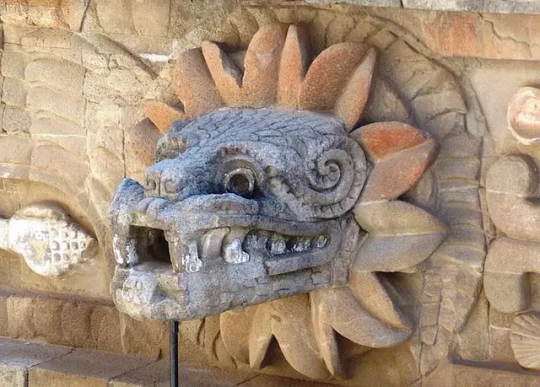
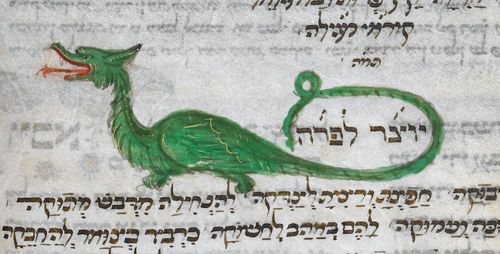
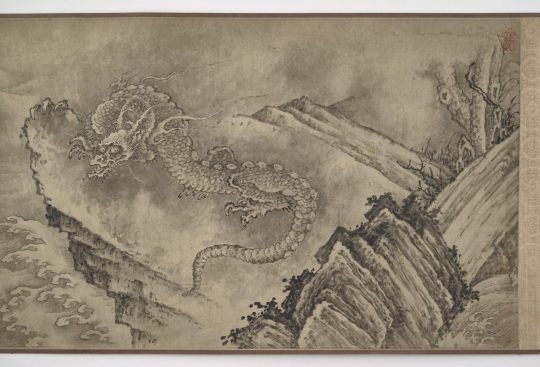

The Dragon Drags On
Though seldom seen today, dragons, of the genus Draconis, are some of the most famous creatures in the world, known for their size, ferocity, elegance, and supposed love for treasure. Though the exact number of dragon species is unknown, there are at least a dozen that are officially recognized; the real number is likely much higher. Once widespread, the range of this group has declined dramatically in the past centuries and populations are now believed to reside in only the most remote parts of the world. Most of what we know of dragons comes from historical records, and study of live specimens has proved impossible due to their rarity.
Because of their global distribution, dragons display a wide variety of morphological traits, including coloration, features, and even the number of limbs. However, some traits are common to nearly all species. Most dragons are thought to be brightly colored, often red, green, or blue; many species also have gold patterns in some form. As reptiles, dragons are covered in scales, though some also posses feathers or manes. Dragons also have extremely long, flexible tails which in some species may act as a supplementary limb. The body is generally long and serpant like, with the exception of the European Dragon and the mushhushshu, or Babylonian dragon. Though all species share an ability to fly, only the European dragon has a functional set of wings. The mechanics of flight for other species are unknown. The European dragon is also noted for its ability to breathe fire; other species such as the Chinese Dragon, or lóng, are more often associated with water.
All dragon species are believed to be carnivorous, though the content of their diet varies from region to region. Due to their large size, it is believed that they predate upon larger mammals such as cattle, sheep, camels, llama, deer, and even megafauna like elephants. Though they lack natural predators, their consistent targeting of livestock and game animals has in the past led dragons into conflict with humans; centuries of dragon hunting for sport and to protect agricultural interest has pushed the dragon to the brink of extinction.
Very little is known about the breeding habits of dragons. Like most large reptiles, they are believed to be solitary and fiercely territorial. It is also likely that they lay eggs, but whether parents provide any kind of care for their clutch or hatchlings is unknown. To date, no record of juvenile dragons has been found, indicating that the rate of survival to adulthood is extremely low. This may be due to predation on hatchlings by opportunistic animals, or adult dragons may attack and kill juveniles to defend their territory, or a combination of the two.
Although they are extremely rare today, dragons have been and continue to be important part of cultures around the world. Ancient civilizations such as the Aztec, Egyptians, and Mesopotamians all revered dragons as dieties. Many other cultures incorporated dragons into their folklore and mythologies, and in many parts of the world the dragon has come to symbolize power, changes in the seasons, or natural disasters, among other things. In more modern times, dragons have come to be associated with wealth, though there is no biological evidence for treasure-hoarding behavior.
Conservation status: Because no dragon species has been sighted for several centuries, they are largely believed to be extinct; however, the IUCN has yet to make a formal declaration. A few hopeful biologists believe that some species still survive in remote locations such as the deep Amazon rainforest or the mountains of Central Asia.
April Fools! I hope you enjoyed this departure from the usual content. I will be on hiatus until April 9th, as I'll be helping a friend with his field research. In the meantime, feel free to send in questions, commons, requests for a particular animal, or proof-of-donation submissions to help the people of Palestine; I'll respond to them all if I have spare time or when I get back!
Photos
A mosaic of a mushhushshu (Draconis babylonia) on the Ishtar Gate, constructed in the 6th century in Babylon; photo by Jan van der Crabben
A bust of an Amazonian dragon (Draconis quetzalcoatl) carved in 150-200 CE in Teotihuacan; photo via Wikimedia Commons
An illustration of a European Dragon (Draconis europa) from 15th century Italy, by the British Library
A Chinese dragon (Draconis qin) depicted as one of the eleven dragons in a Ming dynasty scroll, via the Smithsonian National Museum of Asian Art
A page from an illuminated manuscript of the Hamzanama, dated to the 16th century, showing a Persian dragon (Draconis mughal) via the Museum of Applied Arts in Vienna
105 notes
·
View notes
Text
Because tuatara are very long lived - between 100 and 200 years by most estimates […] - the founding of Aotearoa/New Zealand as a modern nation and the unfolding of settler-wrought changes to its environment have transpired over the course of the lives of perhaps just two tuatara [...].
---
[T]he tuatara (Sphenodon punctatus) [...] [is] the sole surviving representative of an order of reptiles that pre-dates the dinosaurs. [...] [T]he tuatara is of immense global and local significance and its story is pre-eminently one of deep timescales, of life-in-place [...]. Epithets abound for the unique and ancient biodiversity found in Aotearoa/New Zealand. Prized as “Ghosts of Gondwana” (Gibbs 2008), or as denizens of “Moa’s Ark” (Bellamy et al. 1990) or “The Southern Ark” (Andrews 1986), the country’s faunal species invoke fascination and inspire strong language [...]. In rounded terms, it [has been] [...] just 250 years since James Cook made landfall; just 200 years since the founding of the handful of [...] settlements that instigated agricultural transformation of the land [...]. European newcomers [...] were disconcerted by the biota [...]: the country was seen to “lack” terrestrial mammals; many of its birds were flightless and/or songless; its bats crawled through leaf-litter; its penguins inhabited forests; its parrots were mountain-dwellers; its frogs laid eggs that hatched miniature frogs rather than tadpoles [...].
---
Despite having met a reassuringly temperate climate [mild, oceanic, comparable to western Europe], too, the newcomers nevertheless sought to make adjustments to that climate, and it was clear to them that profits beckoned. Surveying the towering lowland forests from the deck of HMS Endeavour in 1769, and perceiving scope for expansion of the fenland drainage schemes being undertaken at that time in England and across swathes of Europe, Joseph Banks [botanist on Cook's voyage] reported on “swamps which might doubtless Easily be drained” [...]. Almost a century later, in New Zealand or Zealandia, the Britain of the South, [...] Hursthouse offered a fuller explication of this ethos: The cultivation of a new country materially improves its climate. Damp and dripping forests, exhaling pestilent vapours from rank and rotten vegetation, fall before the axe [...]. Fen and march and swamp, the bittern’s dank domain, fertile only in miasma, are drained; and the plough converts them into wholesome plains of fruit, and grain, and grass. [...]
[The British administrators] duly set about felling the ancient forests of Aotearoa/New Zealand, draining the country’s swamps [...]. They also began importing and acclimatising a vast array of exotic (predominantly northern-world) species [sheep, cattle, rodents, weasels, cats, crops, English pasture grasses, etc.] [...]. [T]hey constructed the seemingly ordinary agronomic patchwork of Aotearoa/New Zealand's productive, workaday landscapes [...]. This is effected through and/or accompanied by drastic deforestation, alteration of the water table and the flow of waterways, displacement and decline of endemic species, re-organisation of predation chains and pollination sequences and so on [...]. Aotearoa/New Zealand was founded in and through climate crisis [...]. Climate crisis is not a disastrous event waiting to happen in the future in this part of the world; rather, it has been with us for two centuries already [...].
---
[T]he crest formed by the twinned themes of absence and exceptionalism [...] has shaped this creature's niche in the western imagination. As one of the very oldest species on earth, tuatara have come to be recognised [in Euro-American scientific schemas] [...] as an evolutionary and biodiversity treasure [...]. In 1867, [...] Gunther [...] pronounced that it was not a lizard at all [...] [and] placed the tuatara [...] in a new order, Rhynchocephalia, [...] igniting a frenzy of scientific interest worldwide. Specifically, the tuatara was seen to afford opportunities for "astonished witnessing" [...], for "the excitement of having the chance to see, to study, to observe a true saurian of Mesozoic times in the flesh, still living, but only on this tiny speck of the earth [...], while all its ancestors [...] died about one hundred and thirty-five million years ago" [...]. Tuatara have, however, long held special status as a taonga or treasured species in Māori epistemologies, featuring in a range of [...] stories where [...] [they] are described by different climates and archaeologies of knowledge [...] (see Waitangi Tribunal 2011, p. 134). [...]
While unconfirmed sightings in the Wellington district were reported in the nineteenth century, tuatara currently survive only in actively managed - that is, monitored and pest-controlled - areas on scattered offshore islands, as well as in mainland zoo and sanctuary populations. As this confinement suggests, tuatara are functionally “extinct” in almost all of their former wild ranges. [...] [Italicized text in the heading of this post originally situated here in Boswell's article.] [...] In the remaining areas of Aotearoa/New Zealand where this species does now live [...], tuatara may in some cases be the oldest living inhabitants. Yet [...] if the tuatara is a creature of long memory, this memory is at risk of elimination or erasure. [...] [T]uatara expose and complicate the [...] machineries of public memory [...] and attendant environmental ideologies and management paradigms [...].
---
All text above by: Anna Boswell. "Climates of Change: A Tuatara's-Eye View". Humanities, 2020, Volume 9, Issue 2, 38. Published 1 May 2020. This article belongs to the Special Issue Environmental Humanities Approaches to Climate Change. [Bold emphasis and some paragraph breaks/contractions added by me. Text within brackets added by me for clarity. The first paragraph/heading in this post, with text in italics, are also the words of Boswell from this same article. Presented here for commentary, teaching, criticism purposes.]
#i posted commentary about this article in 2020 right after it was first published but i did a sloppy job presenting and discussing it#some might be familiar with boswells 2015 article on longfin eels or her article the stoat free state on weasels in aotearoa#basically she writes on british imperial environmental imaginaries#how settlement tries to reshape a colonys landscape in idealized english image of domesticated home replacing native species with introduce#ecology#abolition#imperial#colonial#landscape#paleo#aotearoa#indigenous#multispecies
71 notes
·
View notes
Text
Chiropterex (Monster)

(artist unknown)
(Back in the distant era of the early 10s, my family got Netflix as a novelty. Nowadays streaming has consumed film and television like a rabid beast, but back then, my brother and I found a little British show called Primeval. Weaned on BBC nature documentaries from a young age, this was an exciting new spin on Walking with Dinosaurs, and we loved it.
The future predator is no question the most iconic creature of the series, a future bat that is both inspired by earlier spec evo and has gone on to inspire many other monster designs, including the earlier moorkutlot. It seems only fitting it be translated to Pathfinder.
By the way, I'm abandoning the proposed evolutionary history the later seasons provide- that these actually evolved to eat humans in a post-apocalyptic cityscape- and make them what I think is most obvious to me.)
CR3 TN Medium Animal HD5
Chiropterex are an aberrant species of roughly wolf-sized terrestrial bat, an arboreal, nocturnal apex predator of the islands it calls home, where no other land mammals have reached. They live in small family groups of about four to six members, typically consisting of a mated pair, a nest of about six children, a few children of previous years who stay around to help, and maybe one or two aunts or uncles. Typically, however, they hunt alone, feeding on seabirds and large moa-like ratites who evolved alongside them. These family groups keep in contact with each other using echolocation, and if a lone hunter runs into a struggle, it will call on the dissembled family to help.
Chiropterex are notorious man-eaters, and many a shipwrecked crew has met its end at a family of ravenous land bats. Many peoples of island cultures consider chiropterex to be evil spirits, and indeed there is at least one island where the magic of The Abyss has infected the local population of these predatory beasts.
Some outsiders have tried to domesticate chiropterex, or at the very least use them as weapons. They are a tempting subject of domestication; they are mobile, intelligent, fast-growing and have large clutch sizes, but all attempts so far have ended disastrously.
Chiropterex Companions
Starting Statistics: AC: +4 Size: Small Speed: 30ft, Climb 30ft Attacks: Bite (1d3), 2 Claw (1d4) Ability Scores: Str:10 Dex:22 Con:8 Int:2 Wis:12 Cha:7 Special Qualities: Blind, Blindsight 90ft, Scent
Lv 4 Advancement: Size: Medium Attacks: Bite (1d4), 2 Claw (1d6) Ability Scores: Str +4 Dex -2 Con +2 Special Qualities: Flurry of Strikes
This hunched over creature has long, clawed arms and a bulbous head that ends in a short, needle-toothed mouth.
Misc- CR3 TN Medium Animal HD5 Init:+5 Senses: Perception:+6 Blind, Blindsight 90ft, Scent
Stats- Str:14(+2) Dex:20(+5) Con:10(+0) Int:2(-4) Wis:12(+2) Cha:7(-2) BAB:+3 Space:5ft Reach:5ft
Defense- HP:25(5d8) AC:19(+5 Dex, +4 Natural) Fort:+4 Ref:+9 Will:+3 CMD:21 Immunity: Gaze and other visual effects Weakness: Vulnerability to Sonic
Offense- Bite +5(1d4+2, 18-20/x2), 2 Claw +5(1d6+2) CMB:+6 Speed:30ft, Climb 30ft Special Attacks: Pounce, Flurry of Strikes +3/+3/+3/+3(1d6+2)
Feats- Dodge, Mobility
Skills- +11 Climb, +10 Stealth, +6 Perception(+8 Racial to Climb)
Special Qualities- Flurry of Strikes
Ecology- Environment- Forest, Urban (Warm) Languages- None Organization- Solitary, Family (2-4 Chiropterex, 6-8 Young Chiropterex) Treasure- None
Special Abilities- Blindsight (Ex)- A chiropterex’s blindsight is echolocation-based; it cannot sense within areas of Silence or similar spells. Flurry of Strikes (Ex)- A chiropterex may, as a full-round action, give a flurry of stabbing strikes from its claws. It makes four Claw attacks at a -2 penalty each.
#soylent original#monsters and races#homebrew#primeval#future predator#speculative biology#speculative evolution
71 notes
·
View notes
Text
Sea Salt Like Glitter: Part One
Summary: You’re a forest ranger. Trees and mammals are your specialty. Mermaids in the ocean? Way outside your area of expertise. Good News: They like you. Bad News: They like you a lot
Mer! Sun x Plus Sized! Reader x Mer! Moon
Part One (Here!), Part Two ,Part Three
Enjoy the first of the wedding month stories! I’m guessing this is going to be around 3-4 parts. I’m a sucker for Sun and Moon and couldn’t leave the Mer AU alone. I hope everyone enjoys!
Warnings: Trapped in Rocks, Blood, Dehydration, Different Species, Threats of Bodily Harm
The best time to go to your beach is around twilight. It’s not technically your beach but your house is the closest one to the water for miles. And technically it’s a ranger station, not a house, but it feels like home after a year of working. You enjoy the calmness of the ocean, gulls screaming and diving overhead. The air smells like salt but you appreciate the burn now. Part of the job is that you have to patrol the waterfront at least once a week and you do that at twilight.
Fredrick Fitzgerald Beach and Forest. One of the most treasured pieces of nature in the country. Nicknamed ‘Pizza Beach’ after the restaurant chain started under the same family, the protected land is looked over by a special kind of warden. A cross between forest ranger, ocean rescue and PR personality, they have the job of living on site full time and making sure people leave the animals alone. And right now, that’s you.
There are other people of course, tour guides and rangers that help at the nature center. You wave at the groups on the hiking trails and listen to the animal facts that you’ve heard 100 times. What you do is different, more secluded. You’re on the other side of the ‘Do Not Cross’ sign and you take your job seriously.
The last few days have been quiet and you’re hoping that the weekend stays that way. Thunderstorms are going to start later in the evening and you’re hoping to be done by then. You had chased some kids off earlier, teenagers looking for ‘a cool place to hang’ and the weather would hopefully deter anyone else from sneaking in.
The water is starting to darken, deep blue going navy. You take a deep breathe, scanning the sand for any trash or people. There isn’t anything as far as the eye can see and you relax, smiling to yourself. Some people think that it’s lonely, being out here for weeks and sometimes months at a time. You enjoy it; you’d rather be with nature than people any day.
You start to hum, watching as the sun finally slips below the horizon. Now your favorite part of the night starts. There are a few moments of darkness before lights begin to flicker under the water. The underwater bioluminescence becomes visible to the naked eye; even after all this time it’s hard to believe that it’s real. The water is much, much deeper than it looks and there’s something in the water that promotes the creatures to glow. Scientists come to study sometimes and you stay out of their way, you’re more of a forest person.
Everything in the water looks normal and you watch the fish dart around, smiling as you stroll part of the beach. You jump as thunder rolls overhead and speed up, calves burning with trying to move quickly through sand. You don’t want to get poured on, walking up the path towards your cabin. The climb is steep and you’re panting by the end of it. The cliffs gives a great view of the water, large rocks creating an outcropping off shore. They jut high out of the water, the largest shaped like an arch. Lazy glowing turns into streaks, fish scattering; must be something bigger under there.
Another clap of thunder bellows and you take off, rain falling in waves. You swear to yourself; your boots had finally just dried out. It’s a struggle to get the cabin door open and you’re glad you know your way around; it’s hard to see anything with the rain and wind. You watch the trees sway for a bit before going to get changed. There’s nothing to do now but wait out the storm.
♥
It’s a couple days before you head back to the beach. Lightening hit one of the larger trees and you’ve spent the last couple days making sure none of the forest caught fire. It’s not ideal but the job can change quickly. After making sure the nature center was alright, you finally head down to the beach. It’s mid-day, much earlier than you would normally go but you’re tired and want to head back early.
The beach is a mess. Seaweed and branches still cover the sand, the waves calm as if nothing had happened. These are some dead smaller fish but nothing too large and you’re thankful for that. Without thinking you begin to clean things up, gathering the sticks closest to you. You half watch a diving gull, seeing it swoop low and then fly off towards the large rock outcrop.
The air leaves your lungs as a gasp, wood falling to the ground at your feet. You can feel your heart starting to pound faster, brain trying to catch up to your eyes. It’s hard to see from the beach but there’s something in the rocks. You curse at yourself for not having your binoculars on you and turn to the stairs, taking a deep breath. It’ll be easier to see up from the cliffs and you’ll be able to tell what it is. Hopefully.
You curse the stairs once you’re at the top, knees aching. You love your job but it’s not made for fat people, even if you’re damn good at it. The sun is hot on your skin and you place your hand over your eyes, squinting at the rocks. It’s a better angle but farther away and you think you see something in the rock arch. It looks like another rock? Or maybe a log? It’s gray and part of you wonders if it’s some kind of ship that’s gotten stuck. The thought quickly leaves as something dark rises out of the water and slams hard against the surface. The gulls scatter with loud screaming and you feel like your eyes are going to pop out of your head.
Some sort of animal is stuck. Maybe a sea lion? A baby whale? Or a dolphin? You go over the possibilities as you rush back to the cabin. There’s a small boat you take out sometimes, mostly to chase fishing boats off. It’s nothing huge but the engine works and it should get you to the rocks.
At least you hope so. Being on the water makes you nervous; you can swim just fine but the boat rocking makes you sick. You don’t think about any of this as you take it to the water, putting it into the back of your truck. There isn’t a direct ride down to the beach but it’s better than nothing.
It takes an hour before you’re in the water heading to the rocks. You made sure to bring as many tools as you could, along with a camera, an emergency phone and gloves. You have no idea what kind of animal that you’re dealing with but if this creature has been stuck since the storm, it’s going to be in rough shape.
The rocks loom high overhead, casting dark shadows on the water. The sun is just starting to sink, even if it’ll take a few more hours. You have a water bottle and resist the urge to drink; you want to see what you’re dealing with first. You turn the boat off about 20 feet away and try to come to terms with what you’re seeing.
The hole in the rocks is about as big as a basketball hoop backboard, the edges not completely smooth but close enough. It’s about two feet above water and something is stuck. Scales so navy they look black are scrapped against the stone, bits of blood smeared as well. It doesn’t move as you get closer, swinging yourself around to get a better look.
You think that you’re looking at its back half. This side of the rocks is shaded by higher formations and it’s a bit difficult to see clearly under the water. Something that you guess must be a tail is slumped into the water but you can’t make out the shape. You grab an oar and paddle closer, letting the waves move you mostly.
Something hits the bottom of the boat and you jump; it was a brush more than anything and of course there are fish out here. The next hit is harder and the boat sways. You place your oar in the water to try to turn and something yanks. You yell as the oar is ripped from your hand and disappears into the water.
A loud rumble fills the air and you watch, horrified and full of awe, as the creature in the rocks moves. The tail rises and you realize that it’s not a tail, it’s webbing. Tentacles shoot out, some grabbing onto the rocks and others into the water. You quickly grab the other oar and move backwards, barely missing the flailing tentacles. Gulls on the rocks take to the sky and the creature begins to shift again.
It doesn’t take long to realize that it’s not doing well, whatever it is. It only struggles for a moment before sagging once more, the tentacles barely holding on. They push against the rocks but it’s weak and the longer you look, the worse it gets. The scales that are out of the water look dull and are starting to crack; it really has been stuck here since the storm.
You know that this isn’t a normal fish. First off, it looks like either a squid or an octopus but both of those would be able to get out of a hole. Also, the hissing and growling coming from the other side of the rock is ominous. You’ve never heard anything like it. You want to head back but you can’t ignore the suffering in front of you. Taking a deep breath, you count to five before paddling to the other side. You ignore the way your hands shake and hope that whatever it is won’t kill you.
Immediately the hissing turns into snarling and you meet blood red eyes. You flinch, holding the oar across your chest like it’ll help you defend yourself. Sharp teeth snap at your and you can feel the waves from the tentacles behind the rock. You’re not in the line of fire and you take a moment to understand what you’re looking at.
A furious face is set on a head coverd in fins, gills fluttering around the neck. The strong torso is covered in navy scales and two arms are digging into the rockface. You look the creature over once and then twice, your eyes always going back up to its face. It looks pissed and like it wants to break you in half. Blood red eyes stare out from a gunmetal gray face and keeps you in it sights.
“Holy shit.” Your voice makes the snarling quiet down, almost like it’s waiting for you to say something. “You’re a mermaid?” You phrase it as a question and the creature, honest to fuck, rolls its mother fucking eyes at you.
At the same time you take it in, the creature looks you over. You’re not much to look at, between your sad little boat and ranger uniform. It eyes you for a little longer between settling back down and looking exhausted. It’s hands, covered in long claws, detangle from the rock and lay against the surface. That’s when you realize it’s pinned.
There’s a log wedged between the rocks, washed up from the storm. The creature is half wrapped around it, the log pushing hard against it’s chest and forcing it’s torso out of the water. One of it’s arms can touch the water but the other is pinned too high up, it’s shoulders pushed far back. It looks painful and you wince in sympathy. You get a snarl for your look, the creature sending you a glare.
It’s eyes close with what you guess is exhaustion, not deeming you a threat. You want to argue but don’t; no need to push your luck. It looks worse from the front, scales dull and patches missing. The rockface has be gauged deeply in the mers struggle to be free.
It’s beautiful. Navy fins on its head and arms lay low, curled up and dull. It’s torso is lighter, the color of sand in moonlight. It’s clearly built for hunting; it might be lean but it’s covered in muscles. Darker scales cover the torso like stars and you know that you can’t leave it here, even if it wants to kill you.
“Hey.” Your voice has the creature opening it’s eyes again but only halfway. It takes you a second to get that they’re squinting at you; the sun must be bothering them. You lick your lips, knowing that it’s crazy to be talking to something this big. “Do you uh, want me to help you?” You wince at how uncertain you sound and the creature looks even more unimpressed than before. You hear something hit the water and assume it’s a tentacle.
You hold up a length of rope and then gesture ot the log. Eyes flicker between rope, your face and log. Some sort of spark comes into its face and it’s claws curl into the rocks slowly. You put the rope down and grab the oar, slowly moving closer.
It’s hard to get a good judge of size because of how it’s stuck but you guess that it’s at least eight feet long, maybe closer to nine. It doesn’t move as you get closer, eyes locked on you. The log is wedged in two places, one part under the water and the other above. When you look down, the bottom half seems to be covered in rocks, probably from the struggling. The only real option is to loop the rope of the top and yank.
“I’m going to go for the top.” You talk and gesture as you move closer, trying to be transparent in your movements. “The bottom half looks too stuck.” You would be concerned by the lack of response if it wasn’t for the red pinned on your face. It takes a little bit to get the boat maneuvered just right and the scrapping of its claws gets louder. You do your best to ignore the impatience; you don’t want to end up in the water today. Not now that you know things like this exist.
There’s a splash in the other direction and you flinch hard, almost falling from where you’re standing. The creature snarls, sharp teeth flashing in the sun and you look over the water. Nothing breaches the surface again and you shake your arms, trying to get rid of the tension. As long as there isn’t another predator you should be alright.
You have to throw the rope a few times before it’s looped just right and you can feel the waves of judgment coming out of the mermaid. Mer creature? You’re not stupid enough to pretend this isn’t some sort of intelligent creature; you’ve been pinching yourself too much for it to be a dream. That doesn’t mean that you want it commenting on your physical abilities and ignore how embarrassed you’re getting. Finally, you get the rope secured and you tug it to make sure. You can sense the growing impatience behind you and vow silently to go faster. It’s already in rough shape and you don’t want it to suffer.
Sending one last silent plea inside your mind, you start the boat engine back up. The creature flinches inside the rock and the gentle rumblings turn more into a hiss. You glance over and it flashes it’s teeth with a ‘get on with it’ feeling. You don’t hesitate, afraid that you’re going to lose your nerve. You throw the engine into reserve and gun it back, the boat taking off as fast as it can.
The rope is pulled taught quickly and you jerk, almost going into the water. Creaky rumbles come from the creature and you want to swear when you realize it’s laughing at you. You ease the boat back forward before going in reverse again, your eyes locked on the log. The first time it didn’t move but the second it seemed to slip. Gritting your teeth you repeat the actions, the log slowly becoming free.
The creature must feel it moving because it begins to push, well as much as it can with it’s chest. It looks painful with the open wounds but it doesn’t care, eyes getting brighter as the log shifts. You give it one last tug and the log comes free, the creature letting out an ear-piercing shriek.
A few things happen at once. Your boat, tugging with all it’s might, flies back once the resistance is gone and you scramble to not turn over. The creature slides backwards into the hole, sliding into the shadow covered water. Lastly, bright red fins crest the water in front of you, darting behind the rock.
Your boat spins for an embarrassingly long time; your arms ache and it takes everything in you to prevent it from flipping. The bottom of the boat has a good couple inches of water but you’re upright. A miracle. The clicking and hissing sounds are all gone now and it’s just you and the gulls. You watch the water once your heart calms down, eyes darting around to see if you can spot the creature in the water.
You wait for ten minutes before slapping your cheeks and turning the boat back towards shore. Your mission was officially done and you need to lay down, maybe have a drink, maybe get high. There was a lot you have to think about and you don’t want to do it in the open water. Two pairs of eyes, one red and one blue, watch as you make your way back to shore and share a silent look. The water barely ripples as they sink below the waves, determined to pay you back in some way.
#fnaf#sun imagine#moon imagine#fnaf daycare attendant#sun x reader#sun x reader x moon#moon x reader#daycare attendant x reader#daycare attendant#mermaid au#mer sun#mer moon#fnaf security breach
185 notes
·
View notes
Text
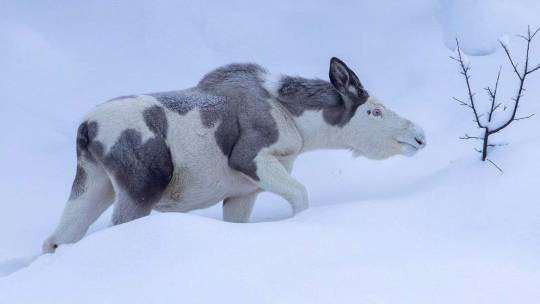
"Norway - 'King of the Forest' is Causing a Stir"
The moose is called the "king of the forest". There are good reasons for that, it is Norway's largest mammal on land.
"I have never seen anything like it, and I have seen many animals throughout my photography career, says photographer Thomas Mørch."
He is talking about the spotted elk that walks around Hallingdal.
A few years ago Albin the albino moose became such a big celebrity that the hunting teams protected him. A white national treasure, which was felled by a Danish hunter in 2011 who had not caught the "protection".
Now the forest has a new moose that stands out. It is not completely white, but mottled.
>>Full article link: https://www.nrk.no/osloogviken/flekkete-elg-vekker-oppsikt-_-er-rammet-av-piebaldisme-1.16675513?fbclid=IwAR0zT8q25thsHFWt0nMJHu8S0IwL5Oig3tfbkanFiP6QSXicYBG3Nqa5EW0
(image credit: Thomas Morch >>https://www.facebook.com/m0rch)
70 notes
·
View notes
Note
Hi! It's me again (I'm transferring to a bachelor's in biology this fall and I love the science that goes into the series so I love that you're exploring this)
Do either of them have hoarding instincts or dietary preferences or are they pretty much human in that regard?
They'd possibly be born with baby teeth, at least in Haze/Hazel's case, would that change anything? (Hazel would probably fit better because Falin is half French on her father's side from what I remember from the Adventurer's Bible and it feels even that they'd both get to name a kid but that's just my opinion)
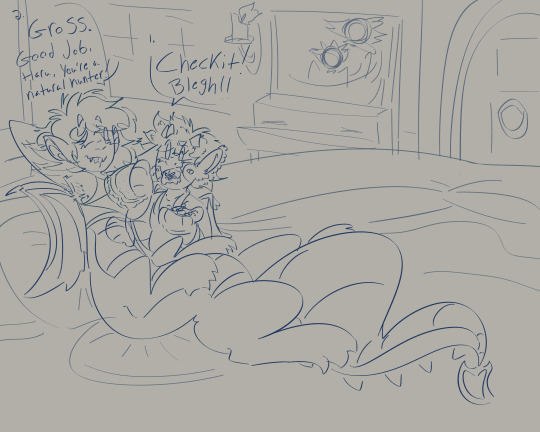
Haru with his mouth full: Checkit!! Blegh!!
Haize: Gross. Good job, Haru, you're a natural hunter!
Welcome back to part 10,000 of me talking about my silly ocs. Hi. hello. Thank you sooo much for coming back with more biology questions for these two hehehe >:]c
Diet Preferences?
These two are quite the oddballs. Haru is an insectivore by simple dragon nature while Haize is a carnivore by hers, though their elven and tallman sides balance them out to be closer to omnivores! Light dragons commonly eat bugs as they're the easiest prey to attract when ur big and flashy though this keeps them very lithe and they typically have more slender builds, though the proteins do help a lot. Conversely, red dragons being mostly carnivores results in their larger build and their obvious frequency to be the most dominant and persevering dragon species- y'know. Because they murk the other ones due to their weaker diets and builds.
Haru started to eat bugs right around the time it was warm enough for him to go outdoors without getting sick, I imagine he would've eaten a butterfly or a dragonfly much to Marcille's horror. Like that vine of the pug eating the butterfly with his owner screaming no! Backtracking a bit though to give some cool facts about baby light dragons because I decide the lore. I'm making them weird half mammal half bird-lizards because I think the variety is cool but this also means that - up until baby light dragons can open their eyes and properly attempt to hunt - they drink milk from their parents! (Whether or not this is crop milk like birds produce is entirely up to the reader's imagination, I will not judge but I will choose either one if asked)
So up until he started going outside, Haru was perfectly content just drinking milk like any other baby- Haize was not. Unlike Haru she was born with baby fangs!! Just little milk teeth to help her get a headstart for the world and such, but she grew hungrier for something more diverse than milk very quickly. Red dragons, unlike light dragons, don't do the whole milk thing so Haize was only partially satiated due to being part elf and tallman but the minute she was allowed to eat soft meats she basically refused to go back. So just imagine like a 1 year old eating various lunch meats for breakfast, lunch, and dinner.
Honestly it was probably for the best, Haize's fangs bit into Marcille a lot and they were worried she might grow a taste for blood if she kept accidentally nicking her mom while trying to eat. She probably would have and it would've been a really bad habit to get rid of because she hadn't developed that big girl brain to be like "Hey maybe drinking blood isn't super cool."
All in all, the Touden-Donato sibs have slightly preferenced diets! Though Haize prefers meats, nectar, and citrus fruits while Haru prefers bugs, ground vegetables, citrus fruits, and any/all milk based desserts (he just really likes them). God if these kids ever got their hands on sorbet it would be a disaster, Falin and Marcille would literally spend a week trying to explain why they cant have ice cream for every meal and have to deal with whining dragonets the whole time.
2. Hoarding Instincts
They do have hoarding instincts! Though this is one of those things that differs from dragon to dragon on how they react with it. Light dragons tend to go for the flashiest treasures to make themselves more appealing and alluring, naturally they like the attention they draw in just from an instinctual standard. They frequently discard rusted, unpolished, or just not as eyecatching treasure all the time. They really just arent particular about the whole thing unless they see you have an interest in something they were previously disinterested in- then they're smug assholes who see their treasure as still having some renewed value. So essentially Envy = Worthy to them, but they arent extremely vain creatures despite their hoarding preference and are actually particularly generous within reason. It's very common for light dragons to gift their young, mates, or siblings with treasures from their own hoards or that they've taken for themselves to gift. Typically though the gifting of treasure is to help younger dragons start their own hoard and have an idea of what to go for when out and about for themselves.
That being said, Haru is a greedly little fucker who wants every single new treasure possible, fuck you. He's very grateful for being part elf and tallman because he's aware that he can make his beautiful treasures last long if he polishes, dusts, and cleans them! So his hoard isn't too huge if only because he's good at maintaining things. Still, if he sees something he tends to want it and is often reprimanded for trying to steal shiny gems, jewels, or artifacts just because he likes them- as Haru often gets tired with his new finds extremely quickly if they begin to bore him or don't compare to his other treasures. When it comes to his hoarding he essentially has the dragon equivalent to having eyes bigger than your stomach.
Haize, however, has your more traditional dragon's hoard of miscellanous treasures, artifacts, coins from birthdays, and prized family gifts. Much of her hoard consists of trinkets Haru grew bored with but that she still saw interest in and wanted to give renewed purpose, she isn't nearly as picky but is very curious and likes to inspect an item before taking it in. She'll often let Haru have a treasure knowing that he'll get tired of it within the hour- though she has been known to assert her place as the eldest sibling if there is a gift for her she particularly wants and Haru usually shies off. Haize doesn't assert herself as the eldest often so he knows it's business if she does for things like food or treasure. Haru keeps her hoard partially in and around the her nest as well as the family nest in Falin and Marcille's room! Her nest in the guardian is where she keeps most of her baby clothes, toys, trinkets, and cloths/blankets. She just feels they're safest there and prefers to sleep near them <3.
Also, fun tid bits on how dragons train their kids to gain treasure!: Typically young dragons get the urge to grab and snatch at shiny things as soon as they're able to crawl around functionally and protect themselves- which is pretty early due to them being predators of a mythical variety- so they'll often try and steal treasure from their parent's hoard! Older dragons use this as stealth training for their young and will often guard their treasure, sitting stop or nearby and continuously removing their children until they manage to sneak by successfully to take a trinket. Typically the larger/shiner/whatever is more impressive for the type of dragon you are is what is most rewarded for by parents but they do punish thinking a bit too big. It's good to know your limits! better to have 5 gold coins than 5 gold bricks you cant carry.
so Falin was very often having to train Haru and haize to amass their own treasures which was much easier for Haize due to her slinky and stealthy body allowing for quicker and quieter movement! Haru had to learn to fight, due to his regular baby limbs and range of movement, which didnt really work because he's so itty bitty but the thought was appreciated by Falin, learning to stand your ground is good too!
#as per usual send in more asks about these guys pretty pleeeease#haize and haru lore#oc lore#farcille#dungeon meshi#marcille dungeon meshi#delicious in dungeon#falin touden#falin dungeon meshi#marcille donato#marcille dunmeshi#dunmeshi falin#farcille fankid lore#farcille fankid#farcille fankids#fankids#ship kids#my ocs#my art#oc asks#chimera/dragon biology
28 notes
·
View notes
Text
Thinking about Eliana getting a case of the zoomies quite some time after the events of TPR after they settled. (Possible minor spoilers ahead, proceed with caution. I am actively trying to avoid giving anything too obvious away tho.)
Thinking about how she’s diurnal double-time since she’s a daytime mammal but also part plant to a degree, so she gets confused as to why she keeps waking up in the middle of the night (not from nightmares as frequently, much to her and the others’ immense relief). She’s sleeping well for the first time in years, she wakes up in the morning feeling fully rested, and she’s no longer fatigued. So why does she rouse when the moon’s at its peak, wide awake, thrumming with energy she just CANT seem to suppress?
She ignores it at first. She tosses and turns and huffs under her breath as she tries her hardest to wrestle herself back to sleep. A lot of times she ends up completely unmaking her bed because of this. The others are puzzled as to why she seems to crabby and how it even happened.
Eventually she gives up. To avoid disturbing the others, she patters up the stairs to walk around the top of the bluff in an effort to tire herself back out. It helps, but it's not enough. One night she caves and just breaks out into a full sprint through the forest on top of the steppe. It works.
She gets into an almost nightly habit of doing this to banish the excess energy. She figures out a trail through the wounds around treasure town and back. She even goes through town once or twice when she’s sure all the shop keepers are asleep. It improves her sleep and mood immensely and the others relax a bit.
Dusknoir gets curious, of course.
So he waits up until she leaves, and he follows. He has to follow the noises into the woods until he’s able to observe her darting through the underbrush to her heart’s content, gleefully yipping as she darts to and fro (entirely subconsciously, he is certain, as she’s so particular about her dignity and pride around others). The dapples of moonlight peeking through the leafy boughs above their heads illuminate her pale fur, helping him keep track of her whereabouts as he keeps a watchful eye, just in case. He understands, now, what she had needed—and he’s exceedingly glad that she found an outlet.
He continues this for a while, and she doesn’t even realize it at first. He spent years perfecting his stealth, after all, and he’s glad to use it for something good for once (bc one never knows when Eliana Kouros might fall into trouble’s way, after all). He almost…enjoys it. Like it’s a game of its own, to keep to the shadows and stay hidden and out of sight. He gets an odd surge of excitement when she darts right past him without her even glancing his way.
It doesn’t last forever, though. On a full moon night he accidental drifts into moonbeams and his rings start to glow involuntarily—it’s been a while since he last moon-bathed, after all, and he should have anticipated that. Elaina’s startled, of course, lets out a sharp sound of shock bc she was near him and felt foolish for being so oblivious, as well as mortified that he’d caught her doing such a “silly” thing (as well as the fact that even though they’ve both healed, bad memories still have a mighty grip on one’s subconscious and instincts). She gets prickly and a little huffy, at first—tries to brush it off and act a bit haughty to deflect his evident amusement—but he doesn’t tease her about it.
He tentatively asks her if she’d like for him to join her.
She blinks and stares at him for a long time in perfect silence. A part of her resists the idea—old wounds still lingered, after all, and why would she ever volunteer to have Dusknoir of all Pokemon chase her? Hasn’t she had enough of that for one lifetime?
He starts to retract his offer, bashful and ashamed himself by prodding that old scar in a way he hadn’t even considered before speaking, but she interrupts him. “I haven’t played tag in a long time,” she murmurs wistfully.
So they learn to play cat and mouse. And they love it.
Eliana is startlingly quick on her feet now that she’s adapted to her body. She has the advantage of ducking under low bushes and hiding in narrow places like under logs or in tree hollows. But her giggles give her away—unmitigated delight and anticipation overpowers her will, and it alerts him to her general direction any time he gets close.
Dusknoir has the advantage of greater reach—and, to a certain extent, speed, because this ghost will absolutely use Shadow Sneak to cheat if he’s losing—simply because it infuriates Eliana and he finds no small amount of amusement in riling her up. Having her rant at him also helps him avoid her longer.
Their raucous, elated laughter wakes Grovyle and Celebi one night. They’re bemused and a touch perplexed by the whole affair, but they decide not to speak on it to preserve their austere companions’ egos.
(I imagine, if they ever brought it up, though, Grovyle and Celebi would love to join in. Pray help them if they decide to do it on a sunny day, because Eliana’s ability almost helps her outpace the old ghost. It’s the only time the others ever get truly worn out.)
#figured some levity would be appreciated after I’ve been talking about all the sad stuff with these two#(I still need a ship name for a tag please god help)#fisara’s scrawlings#pokemon#pokemon mystery dungeon#explorers of sky#dusknoir#leafeon/eliana#headcanons#ao3: in the morning light#grovyle#celebi
33 notes
·
View notes
Photo

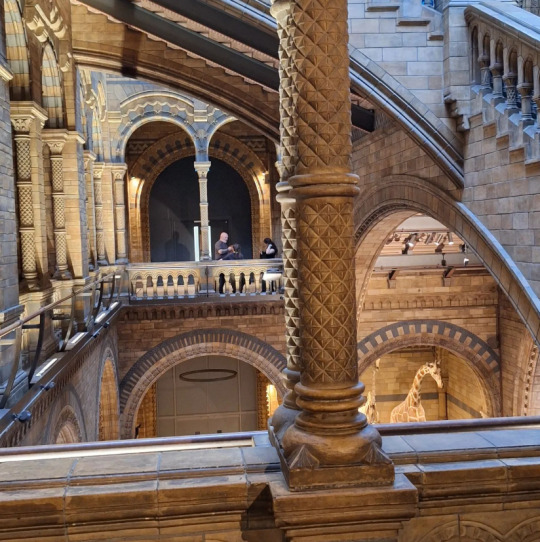
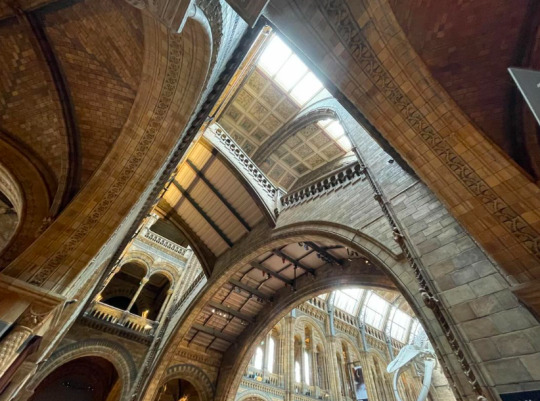
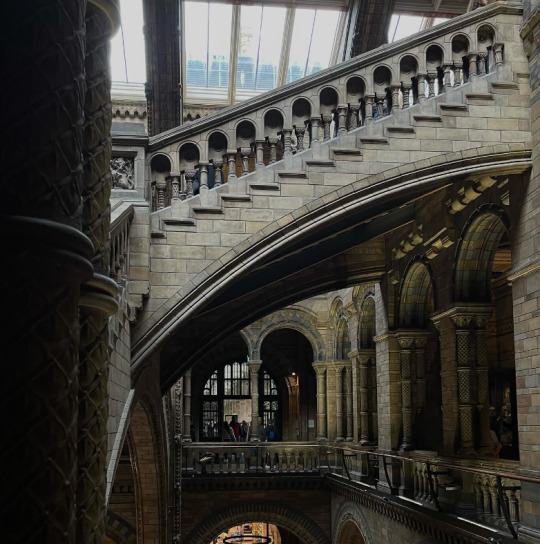
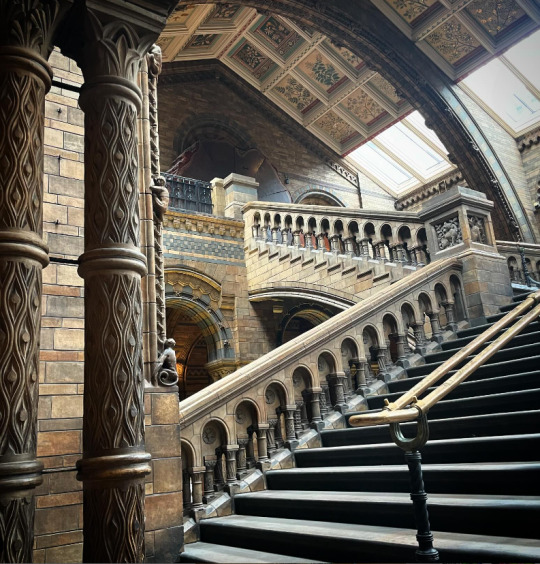



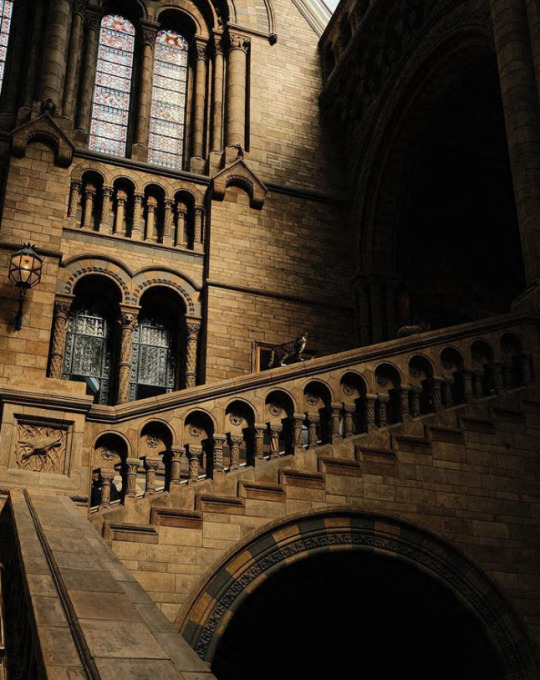
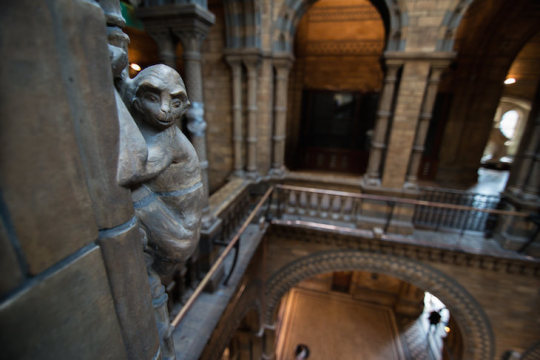

Natural History Museum - London
The Museum first opened its doors on 18 April 1881, but its origins stretch back to 1753 and the career of Sir Hans Sloane, a doctor and collector. Sloane travelled the world as a high society physician. He collected natural history specimens and cultural artefacts along the way. After his death in 1753, Parliament bought his extensive collection of more than 71,000 items, and then built the British Museum so these items could be displayed to the public.
In 1856 Sir Richard Owen - the natural scientist who came up with the name for dinosaurs - left his role as curator of the Hunterian Museum and took charge of the British Museum’s natural history collection. Unhappy with the lack of space for its ever-growing collection of natural history specimens, Owen convinced the British Museum's board of trustees that a separate building was needed to house these national treasures. He drew-up a rough architectural plan in 1859 entitled 'Idea of a Museum of Natural History'. The plan was later referred to by architect Alfred Waterhouse in the design of the Natural History Museum.
In 1864 Francis Fowke, the architect who designed the Royal Albert Hall and parts of the Victoria and Albert Museum, won a competition to design the Natural History Museum. However, when he unexpectedly died a year later, the relatively unknown Alfred Waterhouse - a Quaker architect from the north of England - took over and came up with a new plan for the Museum. Waterhouse used terracotta for the entire building as this material was more resistant to Victorian London's harsh climate. Construction began in 1873, and the result is one of Britain’s most striking examples of Romanesque architecture — considered a work of art in its own right and has become one of London's most iconic landmarks.
Owen's foresight has allowed the Museum to display very large creatures such as whales, elephants and dinosaurs, including the beloved Diplodocus cast that was on display at the Museum for 100 years. He also demanded that the Museum be decorated with ornaments inspired by natural history. And he insisted that the specimens of extinct and living species kept apart at a time when Charles Darwin’s theory of evolution was revealing the links between them. Along with incorporating Owen’s ideas into his plans, Waterhouse also designed an incredible series of animal and plant ornaments, statues and relief carvings throughout the entire building – with extinct species in the east wing and living species in the west. Waterhouse sketched every one of these sculptures in great detail, even asking Museum professors to check the scientific accuracy of his drawings, before creating the fantastic decorations that complement the Museum’s exhibitions. While the building reflects Waterhouse’s characteristic architectural style, it is also a monument to Owen’s vision of what a museum should be. In the mid-nineteenth century, museums were expensive places visited only by the wealthy few, but Owen insisted the Natural History Museum should be free and be accessible to all.
The Museum took nearly eight years to build, and moving the collections from the British Museum in Bloomsbury was a huge job. Relocating the zoological specimens, which included huge whale bones and taxidermy mammals, took 394 trips by horse and cart spread over 97 days. The Natural History Museum finally opened in 1881. The building’s decorative and Romanesque style by Waterhouse is reminiscent of medieval European abbeys, but it is also a monument to Owen’s vision of what a museum should be: the world’s largest and finest institution dedicated to natural history.

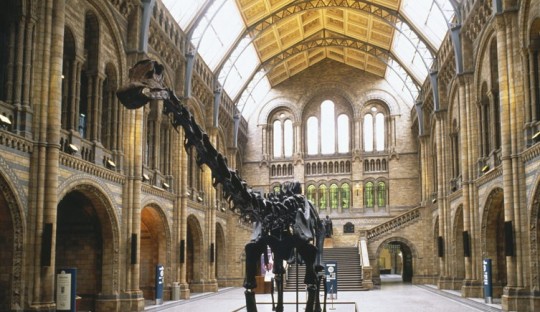

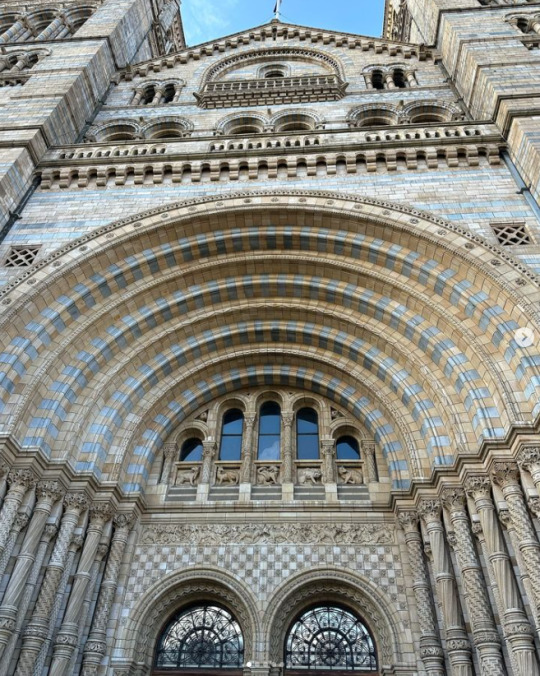
https://www.nhm.ac.uk/about-us/history-and-architecture.html
https://www.nhm.ac.uk/visit/virtual-museum.html
#other's artwork#architecture#Romanesque#Alfred Waterhouse#Sir Richard Owen#terra cotta#Natural History
23 notes
·
View notes
Text
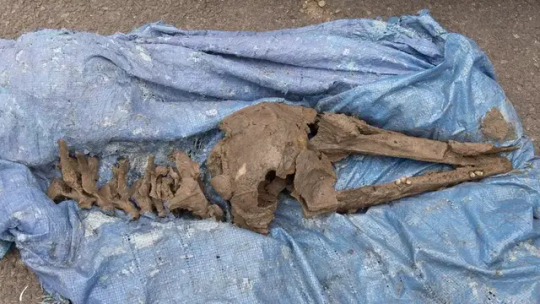
8,000-Year-Old Dolphin Bones Found in U.K.
A man has discovered 8,000-year-old dolphin bones while digging in his back garden.
Paul McDonald, 44, was digging a swimming pool for his children when he struck a bone of the 10ft foot mammal with his digger.
The bottlenose dolphin is thought to have washed up on an ancient shoreline after the last Ice Age.
Archaeologists have described the prehistoric discovery in Causewayhead, Stirling, as "the find of a lifetime".
The father-of-four said he recognised the dolphin's skull by its long snout, rows of teeth and unmistakable shape.
The bones were preserved in clay, around 80cm below the current ground level, for what is thought to have been up to 8,000 years.
With them was a broken tool made from deer antler, which would have been used to carve the meat.
It is thought the dolphin was made into a meal by local hunter gatherers.
Mr McDonald, a medical rep in orthopaedics, who works with bones himself, said: "I was digging away in the swimming pool when I caught something unusual. I rolled it back and came down and pulled it out.
"I saw the roundness of the skull and then saw the snout and teeth and I knew right away it was a dolphin.
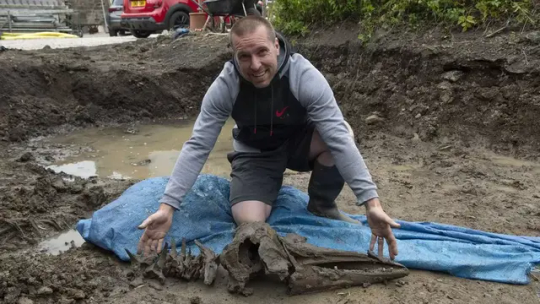
"I googled bottlenose and thought 'wow'. Stuck in clay at that depth I knew it must be old. Now a tool has been found that tells us more about what was going on, it's mind blowing.
"We bought the house six years ago and I've found a few interesting things, like old bottles and coins, but I've always wanted to find something like this."
The skull has been removed by experts from the National Museums Scotland (NMS) so it can be analysed, while the rest of the skeleton will be fully excavated.
Stirling archaeologist Dr Murray Cook said the discovery could be the first of its kind in Scotland in over a century.
The last whale bones found near Stirling were in 1897 but there are no recent records of dolphin discoveries.
Dr Cook said: "It is the find of a lifetime. I don't think one of these has ever been subject to modern excavation.
"After the Ice Age, following the retreat of the ice, this area was a vast inland sea teeming with life.
"Our earliest ancestors would have been walking the shoreline every day for food such as seaweed and shellfish and if a seal, a whale or a dolphin washed up it would be carved into almost immediately.
"The tool made from antler tine means that they were hacking into the dolphin and that's tremendously exciting. The tip has broken off - we still hope to find it - and they've discarded it."

Andrew Kitchener, principal curator of vertebrates at NMS, said: "I've been at the museum for 35 years and this is the first time something has emerged from the clay like this. It is a really interesting and important find.
"It seems like it's a stranded animal that's just sunk into the clay and been preserved all this time until Paul uncovered it, which is kind of a miracle really."
Mr Kitchener said there was lots of analysis to be done, but after they get the bones radiocarbon dated, they can work out the age.
"It's fairly small so possibly a female, and its teeth are fairly worn which suggests it's an older animal.
"We're only at the beginning. It's just exciting to see it emerging from the clay."
The bones in isolation are owned by Mr McDonald, but the antler tool could be declared Treasure Trove, which may mean he could win a reward as the finder.
He said: "I'm just happy to find it and make sure it's looked after and people get to see it."
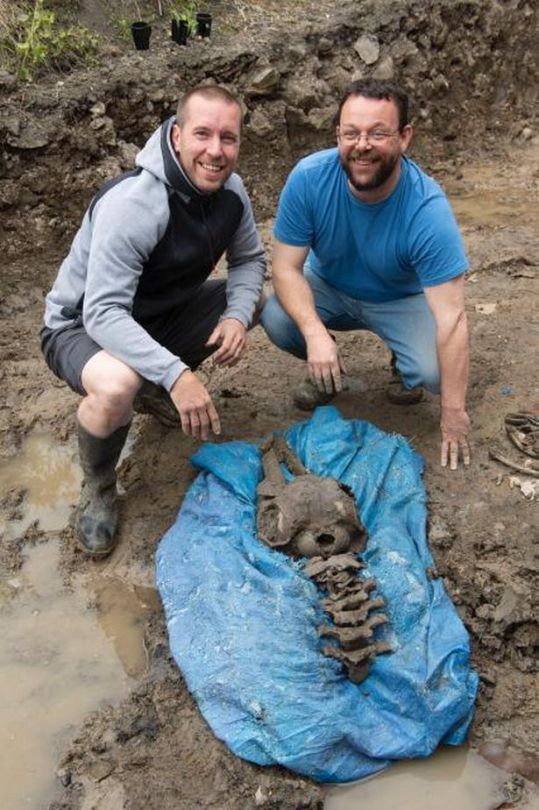
#8000-Year-Old Dolphin Bones Found in U.K.#Causewayhead#fossils#ancient artifacts#archeology#archeolgst#history#history news#ancient history#prehistoric skeleton
95 notes
·
View notes